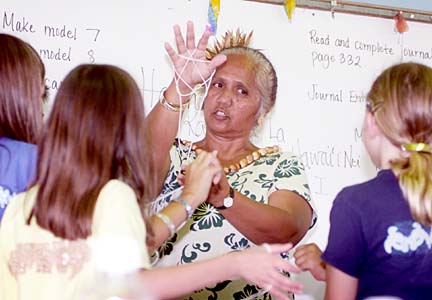
KEN IGE / KIGE@STARBULLETIN.COM
Kupuna Haleaha Montes teaches at Aikahi and Waiau elementary schools.
Public schools save
classroom kupunaIt's decided that new
rules don't apply to
the cultural program
Hawaiian kupuna, who might have been shut out of the classroom by new federal rules, will be able to continue to teach their native culture in the public schools after all.
Superintendent Patricia Hamamoto said yesterday that the kupuna, or elders, do not need to get two-year associate's degrees as required of paraprofessionals under the No Child Left Behind Act, a prospect that had threatened the 21-year-old program.
"That's wonderful news, beautiful news," said kupuna Haleaha Montes, who teaches at Aikahi and Waiau elementary schools. "A lot of my kupuna friends are in their 70s, almost 80s. They wouldn't go back to school at that age to get college credits."
The Department of Education had sought a waiver last August from the federal government for the kupuna program but never received a response. U.S. education officials, however, have said that states have some flexibility to interpret the No Child Left Behind Act, and Hamamoto decided the kupuna do not fall under its requirements.
The law focuses on improving student performance in math and English, and calls for a highly qualified teacher in every classroom. The kupuna bring "added value" to such basic academics, by imparting Hawaii's unique traditions, so they should not be affected, Hamamoto said.
KEN IGE / KIGE@STARBULLETIN.COM
Montes showed students at Aikahi how to play a Hawaiian string game.
"Keeping the kupunas, Hawaii's cultural treasures, out of the classroom would do irreparable harm to native Hawaiian students as well as the cultural foundations of the state," she said.
She informed department heads and principals of her decision in a memo signed yesterday that defines kupuna as "cultural personnel resources" rather than teachers or paraprofessionals.
Seniors in the Kupuna Program have been teaching Hawaiiana, from language to lau hala weaving, in elementary schools since 1981. About 250 kupuna are involved, working part time. Along with preserving indigenous practices and traditions, the program continues the age-old custom of Hawaiian elders passing on cultural knowledge to their grandchildren.
"The program was intended to foster intergenerational relationships," said Puanani Wilhelm, who heads the department's Hawaiian Studies and Language Section.
Insisting on college degrees would have transformed the program into something more academic and shut out many Hawaiian elders in favor of younger people, she said.
"The whole notion of a kupuna is someone who has wisdom because of experience and living the culture," said Claudia Chun, assistant superintendent. "That's what we want them to transfer to the students. What they have to offer is beyond classroom learning."

